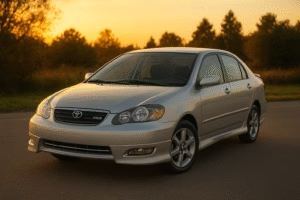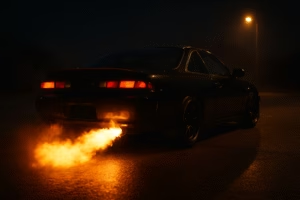There was a time when the name Ralliart meant something. It wasn’t just a badge or a sticker — it was a warning. A sign that somewhere under the hood, Mitsubishi had built something that could tear up gravel, shred tires, and humiliate anything that dared to challenge it on a backroad.
Fast forward to today… and the Ralliart badge is sitting quietly on an Outlander. Yeah — an SUV. With chrome trim. It’s like your favorite rock band coming back together to play a mall food court.
The Birth of a Rally Monster
Ralliart wasn’t born in a boardroom — it came out of rally dust. Back in the late ’70s and ’80s, Mitsubishi’s rally teams were carving their legacy across the world. They didn’t just race — they dominated. Think Lancer 1600 GSR, Pajero Evolution, and eventually, the Lancer Evolution lineup that became the poster car for every early-2000s PlayStation gamer.
Ralliart was the brains and muscle behind all that. It wasn’t just a tuning division — it was the beating heart of Mitsubishi’s motorsport identity.
The engineers at Ralliart were obsessed. They turned family sedans into gravel-slinging weapons. They built AWD systems that could read a driver’s mind. They made turbos whistle like angry tea kettles. And for a glorious stretch of time, they made Mitsubishi one of the coolest names in the car world.
The Lineup That Defined an Era
Ralliart wasn’t a one-trick pony. While the Lancer Evolution grabbed the spotlight, the Ralliart lineup had depth — from rugged SUVs to quirky hatchbacks, all injected with a dose of rally attitude.
- Lancer Ralliart: The famous “almost-Evo.” Turbocharged, AWD, and just a few bolts away from greatness.
- Galant VR-4: The original family sedan that secretly dreamed of rally stages.
- Colt Ralliart Version-R: A tiny hatch with a turbo that thought it was ten times bigger.
- Pajero Evolution: The Dakar-winning monster that looked like a toy until it started eating sand dunes.
- Mirage Ralliart: Lightweight, high-revving fun back when “small” meant “quick.”
- Outlander Ralliart: The modern comeback… but let’s be honest, this one’s more grocery run than gravel run.
Each wore the badge proudly, and each carried that same mischievous DNA — fast, practical, and just a little bit unhinged.
When Ralliart Forgot Its Own Name
Then something happened. Mitsubishi changed direction. The Evo X came and went, the Lancer name disappeared, and Ralliart was quietly shelved.
And when it came back? It wasn’t the fire-breathing hero we hoped for — it was… mild. The new Ralliart models are mostly cosmetic packages. Red accents. Chrome bits. Floor mats that whisper “performance.”
Somewhere, a turbo just cried.
It’s like seeing a retired boxer doing smoothie commercials — you’re happy they’re still around, but deep down, you miss the punches.
The Spirit Still Lives On
The thing about Ralliart is — it can’t really die. Not when there are still fans wrenching on old Lancer Ralliarts, tuning Colt Ralliarts in Japan, and daily-driving Pajero Evolutions like it’s still 1999.
Those cars were built differently. They were raw, mechanical, and full of personality. They made you feel like a rally driver even when you were just going to work. And that’s something today’s shiny “performance trims” can’t fake.
Ralliart might not be wild anymore, but the people who love it still are.
The Legacy of the Badge
The Ralliart logo used to mean speed with soul. It represented the kind of engineering that didn’t need validation — just a dirt road and a full tank.
Now, when you see that badge, it’s easy to feel nostalgic — maybe even a little sad. But it also reminds us of what Mitsubishi once was: bold, loud, and brilliant in its chaos.
So here’s to Ralliart — the division that gave us rally legends, turbo dreams, and a reminder that even the “almost Evos” of the world deserve a little respect.
Because no matter how many badges they slap on SUVs, real car people remember what that name once stood for.
Join Our Automotive Community!
Subscribe to our YouTube channel




